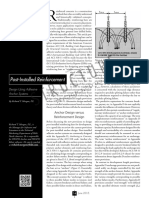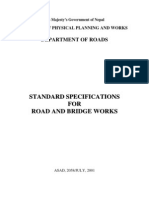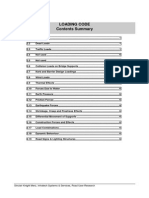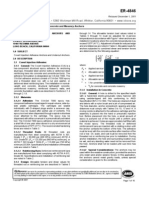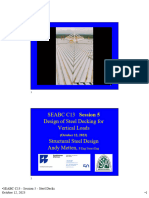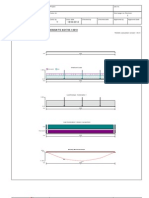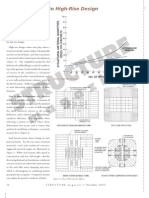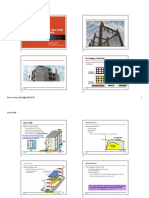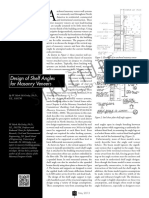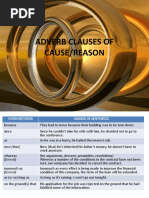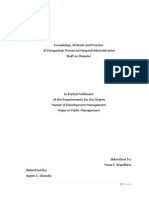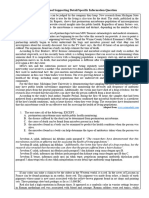Tilt-Up Building Seismic Design - Precast or Cast-In Place
Tilt-Up Building Seismic Design - Precast or Cast-In Place
Uploaded by
alexitomichaelCopyright:
Available Formats
Tilt-Up Building Seismic Design - Precast or Cast-In Place
Tilt-Up Building Seismic Design - Precast or Cast-In Place
Uploaded by
alexitomichaelCopyright
Available Formats
Share this document
Did you find this document useful?
Is this content inappropriate?
Copyright:
Available Formats
Tilt-Up Building Seismic Design - Precast or Cast-In Place
Tilt-Up Building Seismic Design - Precast or Cast-In Place
Uploaded by
alexitomichaelCopyright:
Available Formats
Tilt-Up Building Seismic Design
Precast or Cast-in Place?
By Joe Steinbicker, P.E., S.E. and John Lawson, S.E.
E
Tilt-up buildings have been successfully designed and constructed
throughout the United States for over fifty years. Today, the tilt-
up method of construction is used extensively to build all types
R
of buildings, currently at a rate of 300,000,000 square feet of
tilt-up concrete panels constructed in the United States each
year. Recently, with the adoption of the 2006 edition of the
U
International Building Code (IBC) in conjunction with the
ASCE 7-05 Minimum Design Loads for Buildings t and Other
igh what
T
Structures, there has developed some confusion p y rover build
Co
ing type should tilt-up construction be classified for the purposes
C
of seismic design monolithic cast-in-place or precast?
Traditional Precast
e
U
Courtesy of John Lawson
vs. Tilt-up
i n Structural Wall
R
Traditionally, precast concrete buildings Tilt-up panels are generally handled
Classification
z
are considered as structures comprised only once. They are lifted or tilted from
of numerous small individual pieces of Current tilt-up engineering practices
T
the casting slab and erected in their final
concrete cast at an off-site plant and
trucked to the jobsite for assemblage
g a
position in one, continuous operation.
Tilt-up panels are generally of such large
typically use the tilt-up concrete wall
panels as Structural Walls, whether one
S
and erection. These traditional precast size and weight that they can only be story or multi-story. ASCE 7-05 defines
elements are often in the form of beam
a constructed on site and in close proximity a Structural Wall as, Walls that meet
Structural PracticeS
elements, column elements, horizontal to their final location in the structure. the definition for bearing walls or shear
m
plank elements, and narrow vertical wall Panel gravity loads are supported walls. Furthermore, a Bearing Wall is
elements. Generally, seismic loads are directly by the foundation instead of defined as, Any wall meeting either
resisted by coupling beams to columns being supported by a structural frame. of the following classifications: 1) Any
for frame resistance, and coupling narrow Typically, tilt-up panels are erected before metal or wood stud wall that supports
wall elements together for composite shear the structural frame. Tilt-up panels are more than 100 lbs/linear ft (1,459 N/m)
wall resistance. In these situations, the usually load-bearing for gravity loads of vertical load in addition to its own
individual element has little or no lateral and lateral loads. In fact, a whole weight, 2) Any concrete or masonry
resistance on its own, but relies upon the industry developed around the tilt-up wall that supports more than 200 lbs/
assemblage to achieve lateral resistance. construction method. Tilt-up concrete linear ft (2,919 N/m) of vertical load
The American Concrete Institute (ACI) construction is a unique form of site-cast in addition to its own weight, and a
defines precast concrete in Section 2.2 of precast construction and, as such, has its Shear Wall (vertical diaphragm) as, A
Building Code Requirements for Structural own specialized set of design parameters wall, bearing or nonbearing, designed
Concrete (ACI 318-05) and Commentary and construction techniques. to resist lateral forces acting in the plane
(ACI 318R-05) as a Structural concrete By their nature, tilt-up panels are of the wall (sometimes referred to as a
element cast elsewhere than its final individually stable wall elements seldom vertical diaphragm). Walls that do not
practical knowledge beyond the textbook
position in the structure. Under this requiring coupling devices for composite meet these criteria are instead classified
broad definition, tilt-up concrete action. Penetrations within walls are as non-structural components. Clearly,
construction can be classified as site-cast surrounded by deep beams above which, tilt-up buildings are generally comprised
precast. The ACI clarified this with ACI in turn, are monolithically cast to wall of Structural Walls.
318-95 when the following was added pier elements at the sides. The only With this in mind, the tilt-up building
to Chapter 16, Precast Concrete, in the discontinuities are at the vertical panel structural system would be classified as a
Commentary Section R16.1.1, Tilt joints, often twenty or thirty feet apart, bearing wall system as defined by ASCE
up concrete construction is a form of and the panel-to-footing interface. The 7. In ASCE 7, Table 12.2-1, Design
precast concrete. As stated in Chapter performance and ductility of this lateral Coefficients and Factors for Seismic
1 of the ACI Tilt-Up Construction Guide force resisting system is closer to cast Force-Resisting Systems, there are now
(ACI 551), several features make the in-place construction than traditional three categories under the heading for
tilt-up construction method a unique precast. Historically, the authors are bearing wall systems that potentially
form of precast concrete, different from unaware of any seismic performance apply to tilt-up buildings as a form of
traditional methods: problems at these interfaces. precast concrete construction. These are
STRUCTURE magazine 10 January 2008
Dr. S.K. Ghosh
S.K. Ghosh Associates, Inc. NCSEA WEB SEMINAR
Dr. S.K. Ghosh heads his own consulting
practice, S.K. Ghosh Associates, Inc.,
Two Part Series:
in Palatine, Illinois and Laguna Niguel, Tuesday, January 8th, 2008
California. He was formerly Director,
Engineering Services, Codes, and Design of Reinforced Concrete Shear Walls
Standards, Portland Cement Association, Skokie, Illinois,
and is Adjunct Professor of Civil Engineering at the
E
University of Illinois at Chicago. Tuesday, January 15 , 2008
th
He has influenced seismic design provisions in the
Q & A on Chapter 16 (Structural Design) and
R
United States for many years by serving on or chairing
numerous committees and advisory panels. He Chapter 19 (Concrete) of the 2006 IBC
specializes in the analysis and design, including wind
U
and earthquake resistant design, of reinforced and 10:00 am - 11:30 am Pacific 12:00 pm - 1:30 pm Central
prestressed concrete structures. He is a member of 11:00 am - 12:30 pm Mountain 1:00 pm - 2:30 pm Eastern
the Boards of Direction of ACI and EERI (Earthquake
ht
yrigPart 1 -- This seminar will present systematic background on shear wall
T
Engineering Research Institute).
In addition to authoring many publications in the area Cop design provisions for regions of high seismicity, as they have evolved in
recent years. It will provide a detailed explanation of the current ACI 318-05
of structural design, he has investigated and reported
C
shear wall design provisions for buildings in high seismic design categories.
on structural performance in most recent earthquakes.
The seminar will address the design of shear walls for flexure and axial
loads as well as for shear forces. Attendees will be allowed to ask questions
Seminar Cost for January 8th
e
U
intermittently, and responses will be provided.
$250 per connection.
n
Part 2 - The Seismic Design of Reinforced Concrete Shear Walls seminar of
Seminar Cost for January 15th
i
R
the previous week will probably lead to some follow-up questions. Since the
$150 per connection for registrants of the
z
2006 IBC structural provisions have been applied to designs, SKGA has re-
January 8th Seminar. Other registrants - $250. ceived numerous questions on specific design-related provisions. This seminar
T a
will consist of two parts, the first on 2006 IBC Chapter 16 and the second on
Information: 312.649.4600 x202 Chapter 19. Dr. Ghosh will open each segment with a brief statement. He
g
Registration: www.ncsea.com will then take questions from the audience and respond to them.
S a
ADVERTISEMENT For Advertiser Information, visit www.STRUCTUREmag.org
Ordinary Precast Shear Walls, Intermediate through 21.2.7, and 21.7 shall
m
Precast Shear Walls and Special Reinforced be satisfied. The commentary
Concrete Shear Walls. The category of for this definition states, The
Intermediate Precast Shear Walls is new, provisions of 21.8 are intended
and represents a transition in detailing and to result in a special precast
expected performance between ordinary and structural wall having mini
special systems. With the lack of the word mum strength and toughness
precast, the applicability of the Special equivalent to that for a special
Reinforced Concrete Shear Wall category to reinforced concrete structural
tilt-up may not be immediately obvious, but wall of cast-in-place concrete.
a quick reference to ACI 318-05 will clarify This establishes that a Special
this application. Precast Structural Wall is equiv
The intent of ACI 318-05 towards the alent to a Special Reinforced
proper classification of Structural Walls can Concrete Structural Wall.
be obtained by reviewing the provisions in Part of the initial confusion
conjunction with the commentary. Chap regarding the proper classifi
ter 21 of ACI 318-05, Special Provisions for cation of tilt-up construction
Seismic Design, Section 21.1 Definitions, stems from the development
provides the following guidance. Structural of the precast concrete seis
Walls are defined as Walls proportioned to mic design provisions. Much
resist combinations of shears, moments, and of the research work has been
axial forces induced by earthquake motions. directed towards investigating
A shear wall is a structural wall. Structural the seismic performance of
walls shall be categorized as follows: A Spe traditional precast concrete Courtesy of John Lawson
cial Precast Structural Wall is defined as, A structures with improved connections. precast concrete systems. Inadvertently, these
precast wall complying with the requirements The landmark research associated with the provisions are extending to site-cast tilt-up
of 21.8. In addition, the requirements for PRESSS (Precast Seismic Structural Systems) construction, because tilt-up falls under the
ordinary reinforced concrete structural walls Research Program has greatly influenced broad umbrella of precast concrete. Although
and the requirements of 21.2.2.3, 21.2.3 the specific ACI 318 seismic provisions for the precast concrete seismic provisions may
STRUCTURE magazine 11 January 2008
at first seem awkward to apply to tilt-up of the connection that are not designed to their large size and relatively low force levels,
construction, a rational approach can be yield shall develop at least 1.5Sy. Some are stable as individual elements and do not
developed by understanding the intent of designers interpret this to mean that tilt-up require panel-to-panel connections or panel
the provisions. panels used as Intermediate or Special Precast to-footing connections to resist overturning
Structural Walls must be connected to the (tension) forces due to earthquake forces.
Navigating the Code Provisions foundation. However, the Commentary Thus, tie down connections to the footings
Tilt-up walls in seismic regions must for Section 21.13 Intermediate Precast are not required since no design tensionforce
E
follow Intermediate and Special Precast Structural Walls states in part, Connections is calculated.
Structural Walls provisions of 21.13.2 In between precast wall panels or between wall Chapter 16 of ACI 318-05, Precast Concrete
connections between wall panels, or panels and the foundation are required to Section 16.5.1.3 (c) states, When design
R
between wall panels and the foundation, resist forces induced by earthquake motions forces result in no tension at the base, the ties
yielding shall be restricted to steel elements and to provide for yielding in the vicinity of required by 16.5.1.3(b) shall be permitted to
or reinforcement. and 21.13.3 Elements connections. Many tilt-up panels, due to be anchored into an appropriately reinforced
U
concrete floor slab on grade. The seismic
ht shear forces can also be transferred between
yrig
T
Cop the tilt-up panels and the floor slab on
grade, just as they are transmitted between a
C
suspended structural concrete floor slab and a
concrete structural wall. This is often analyzed
with the shear friction principles of ACI 318
e
U
through the use of doweling reinforcement.
n
Continuing the load path, the floor slab on
i
R
grade must be designed to resist the forces
z
being transferred as well.
T a Conclusion
g
S
Tilt-up construction is a unique form of
precast concrete sharing many similarities
a with monolithic cast-in-place concrete. As
concrete code provisions have become more
m
ADVERTISEMENT For Advertiser Information, visit www.STRUCTUREmag.org
prescriptive and construction-type specific,
confusion and unintended interpretations are
always a risk. Fortunately, tilt-up construction
has performed very well in terms of acting
as a lateral force resisting system. Where it
can be argued whether the precast seismic
provisions were originally intended to apply
to tilt-up, this article demonstrates that a tilt-
up building can be navigated through these
provisions successfully without compromising
expected performance.
Joe Steinbicker, P.E., S.E. is President
of Steinbicker & Associates. He is a
founding member of the Tilt-Up Concrete
Association and currently a member of
their Board of Directors. He is also a
founding member and past chairman of
ACI Committee 551 Tilt-Up Concrete
Construction. He can be reached via email
at joes@sai-engineers.com.
John Lawson, S.E. is Vice President
of Kramer & Lawson, Inc. He is the
recipient of the 2006 TCA Engineering
Achievement Award for his involvement in
BOOTH #N1423 clarifying code provisions related to tilt-up
construction. He can be reached via email
at john@kramerandlawson.com.
STRUCTURE magazine 12 January 2008
You might also like
- Quarter 1 - Module 8 Disaster RiskDocument23 pagesQuarter 1 - Module 8 Disaster RiskMC MirandaNo ratings yet
- Design Buildings Common Irregularities: Guide To THE OFDocument10 pagesDesign Buildings Common Irregularities: Guide To THE OFade musrianto0% (2)
- C StrucDesign Morgan Jun151 PDFDocument3 pagesC StrucDesign Morgan Jun151 PDFkyleNo ratings yet
- 6.1 Structure Behavior of High Rise Buildings Under Dynamic Forces and Other Concepts PDFDocument254 pages6.1 Structure Behavior of High Rise Buildings Under Dynamic Forces and Other Concepts PDFManowar HossainNo ratings yet
- Permanent Seismically Induced Displacement of Rock-Founded Structures Computed by The Newmark ProgramDocument204 pagesPermanent Seismically Induced Displacement of Rock-Founded Structures Computed by The Newmark Programnenad lazicNo ratings yet
- Theoretical Analysis of Soil Nailing: Design, Performance and Future AspectsDocument10 pagesTheoretical Analysis of Soil Nailing: Design, Performance and Future AspectsHima SNo ratings yet
- Capacity Design of Grouted Anchors: TransactionsDocument8 pagesCapacity Design of Grouted Anchors: TransactionsРостислав ВасилевNo ratings yet
- Wood Shear Wall Design Examples For WindDocument4 pagesWood Shear Wall Design Examples For WindAbdurrahman ÇINARNo ratings yet
- ColdesDocument64 pagesColdesengsys0No ratings yet
- Wood Shear Wall Design ExampleDocument7 pagesWood Shear Wall Design ExampleAbdurrahman ÇINARNo ratings yet
- Standard Specifications OF rOADS AND bRIDGES PDFDocument572 pagesStandard Specifications OF rOADS AND bRIDGES PDFSushmit SharmaNo ratings yet
- Cold Formed Track DesignDocument8 pagesCold Formed Track DesignJayNo ratings yet
- Guide For Precast Concrete Wall Panels: Reported by ACI Committee 533Document56 pagesGuide For Precast Concrete Wall Panels: Reported by ACI Committee 533Josue Hilari MejiaNo ratings yet
- t02 Austroads LoadingsDocument11 pagest02 Austroads Loadingskushar_geoNo ratings yet
- Seismic Behavior and Design of Composite Steel Plate Shear Walls PDFDocument73 pagesSeismic Behavior and Design of Composite Steel Plate Shear Walls PDFmanpreetkhanujaNo ratings yet
- Some Practical and Theoretical Aspects of Grouted Soil AnchorDocument12 pagesSome Practical and Theoretical Aspects of Grouted Soil AnchorGeorge HaileNo ratings yet
- Simspon at Epoxy Anchor - ICC ER-0263Document19 pagesSimspon at Epoxy Anchor - ICC ER-0263pandavision76No ratings yet
- ICBO CIA-7000 Anchor SystemDocument16 pagesICBO CIA-7000 Anchor SystemDon RockwellNo ratings yet
- TTWB 2014 Breneman CLT Floor DesignDocument58 pagesTTWB 2014 Breneman CLT Floor DesignSimona SavastreNo ratings yet
- Design of Stiffened Slabs-On-grade On Shrink-SwellDocument23 pagesDesign of Stiffened Slabs-On-grade On Shrink-SwelljoneNo ratings yet
- 68 36 301-1-SEABC C13 2023 Session 5 Decks 2PerPage ColorDocument131 pages68 36 301-1-SEABC C13 2023 Session 5 Decks 2PerPage Colorelidstone@hotmail.comNo ratings yet
- Building The Performance You Need: A Guide To State-of-the-Art Tools For Seismic Design and AssessmentDocument28 pagesBuilding The Performance You Need: A Guide To State-of-the-Art Tools For Seismic Design and AssessmentMarkito SantosNo ratings yet
- 1129 2f PDFDocument76 pages1129 2f PDFMTCLSNo ratings yet
- Vibration Analysis of Structure Using Tune Mass DamperDocument7 pagesVibration Analysis of Structure Using Tune Mass DamperAnonymous kw8Yrp0R5rNo ratings yet
- 2024 Outrigger Action in Tall Core Wall Buildings With Flat PlateDocument9 pages2024 Outrigger Action in Tall Core Wall Buildings With Flat PlateHawsar Omer HamaNo ratings yet
- Shear Strength of Reinforced Concrete Deep BeamsDocument4 pagesShear Strength of Reinforced Concrete Deep Beamsnevinkoshy100% (1)
- Plastic Analysis in StaadDocument6 pagesPlastic Analysis in Staadpetronashscribdid100% (1)
- Understanding The Complexities of Designing Diaphragms in Buildings For EarthquakesDocument21 pagesUnderstanding The Complexities of Designing Diaphragms in Buildings For Earthquakesjunhe898No ratings yet
- Bray-EQ Fault Rupture-CUEE2009Document9 pagesBray-EQ Fault Rupture-CUEE2009Gilmar BastidasNo ratings yet
- Seismic Performance and Design of Precas PDFDocument13 pagesSeismic Performance and Design of Precas PDFCsongor BiroNo ratings yet
- (1963) Housner - The Bevavior of Inverted Pendulum Strtuctures During EarthquakesDocument15 pages(1963) Housner - The Bevavior of Inverted Pendulum Strtuctures During EarthquakesEdison GuzmanNo ratings yet
- Gazetas 1991Document41 pagesGazetas 1991RAUL HANDERNo ratings yet
- Awc Des410 100809Document141 pagesAwc Des410 100809Siew Hiong JongNo ratings yet
- H815 Design of All-Plywood BeamsDocument29 pagesH815 Design of All-Plywood BeamsbabshuagNo ratings yet
- Proposed AASHTO Guidelines For Performance-Based Seismic Bridge Design (2020)Document87 pagesProposed AASHTO Guidelines For Performance-Based Seismic Bridge Design (2020)kaiNo ratings yet
- Tilt Up DesignDocument27 pagesTilt Up DesigntwinniesNo ratings yet
- ADAPT TN290 Vibration AnalysisDocument20 pagesADAPT TN290 Vibration AnalysisMai KawayapanikNo ratings yet
- Influence of Openings On Shear Capacity of Wooden Walls - Bruno DujicDocument13 pagesInfluence of Openings On Shear Capacity of Wooden Walls - Bruno DujicIonFlorentaNo ratings yet
- Design Guide 7 Errata PDFDocument10 pagesDesign Guide 7 Errata PDFelidstone@hotmail.comNo ratings yet
- Guide To Shotcrete: by Lars BalckDocument4 pagesGuide To Shotcrete: by Lars BalcklijiabinbinNo ratings yet
- Seismic Design Guide For Masonry Buildings: Donald Anderson Svetlana BrzevDocument113 pagesSeismic Design Guide For Masonry Buildings: Donald Anderson Svetlana BrzevVladimir Sánchez CalderónNo ratings yet
- MUK-GEN - 700 - 000 - 0001-C2-Specification For Piling and Embedded Retaining WallDocument47 pagesMUK-GEN - 700 - 000 - 0001-C2-Specification For Piling and Embedded Retaining WalloscarNo ratings yet
- Cmaa As 3700 Online Fact SheetDocument5 pagesCmaa As 3700 Online Fact SheetMoren AlfonsoNo ratings yet
- Reinforced Masonry Under Compression Changes To As 3700 2018Document5 pagesReinforced Masonry Under Compression Changes To As 3700 2018skooba84No ratings yet
- 68 36 302-2-SEABC C13 2023 Session6 Axially Loaded Members 2PerPageColorDocument130 pages68 36 302-2-SEABC C13 2023 Session6 Axially Loaded Members 2PerPageColorelidstone@hotmail.comNo ratings yet
- Understanding The Difference Between Structural and Non-Structural Foundation CracksDocument2 pagesUnderstanding The Difference Between Structural and Non-Structural Foundation CracksEvello MercanoNo ratings yet
- Group Efficiency Clay PDFDocument4 pagesGroup Efficiency Clay PDFthakrarhitsNo ratings yet
- Cofar FloorDocument10 pagesCofar FloorMarcin KrólNo ratings yet
- Limit State Response of Composite Columns and Beam-Columns Part I, Roberto Leon PDFDocument18 pagesLimit State Response of Composite Columns and Beam-Columns Part I, Roberto Leon PDFHeriberto Bórquez UrquidyNo ratings yet
- Timber Examples - TeddsDocument19 pagesTimber Examples - TeddsTom KwoNo ratings yet
- Fyfe Design Manual Rev 9 (2011-01-13)Document74 pagesFyfe Design Manual Rev 9 (2011-01-13)César GuevaraNo ratings yet
- 3 - Concentrically Braced Frames PDFDocument65 pages3 - Concentrically Braced Frames PDFRicho MSNo ratings yet
- Hapter (5) : Wall ColumnDocument17 pagesHapter (5) : Wall Columnraunak upadhyayaNo ratings yet
- 1 2 ConstructionDocument13 pages1 2 ConstructionLuis Hernán Guillén CardonaNo ratings yet
- Planning & Designing Site Safety S I T e W o R K Site Construction Electrical WorkDocument1 pagePlanning & Designing Site Safety S I T e W o R K Site Construction Electrical Worknz jumaNo ratings yet
- C StructuralForum Powell Nov081Document3 pagesC StructuralForum Powell Nov081SakisNo ratings yet
- High Rise BuildingDocument5 pagesHigh Rise Buildingmadina1386No ratings yet
- Lecture15 - Design and Detailing of RC Shear Walls-Is13920Document16 pagesLecture15 - Design and Detailing of RC Shear Walls-Is13920Rahul SehgalNo ratings yet
- Design of Shelf AngleDocument3 pagesDesign of Shelf AngleMohanNo ratings yet
- Concrete: Types of Building / Structural Design ConceptDocument2 pagesConcrete: Types of Building / Structural Design ConceptJhune UrabaNo ratings yet
- 1) Pavement Design ConceptDocument31 pages1) Pavement Design ConceptعزNo ratings yet
- Team Planner - OverallocationDocument2 pagesTeam Planner - OverallocationJames Michael BacunaNo ratings yet
- 2017 .AU ISBN Precast and Tiltup Concrete For Buildings 2001 04Document88 pages2017 .AU ISBN Precast and Tiltup Concrete For Buildings 2001 04alexitomichaelNo ratings yet
- MS 09 - Ccanz - Org.nz PDFDocument56 pagesMS 09 - Ccanz - Org.nz PDFalexitomichaelNo ratings yet
- 2 SESOC Interim Design Guidance 0.9 ReslienciaDocument49 pages2 SESOC Interim Design Guidance 0.9 ReslienciaalexitomichaelNo ratings yet
- 2 RT4b Lecture 2016 Lasse Rajala - OKDocument61 pages2 RT4b Lecture 2016 Lasse Rajala - OKalexitomichaelNo ratings yet
- ProposalrccDocument10 pagesProposalrccBijan Babu ShresthaNo ratings yet
- 3.3 Volcanic-HazardsDocument23 pages3.3 Volcanic-HazardsLumen HistoireNo ratings yet
- Yangon Zoning MapDocument18 pagesYangon Zoning MapKarlos WeberNo ratings yet
- Adverb Clauses of CauseDocument7 pagesAdverb Clauses of CauseEmanuella RadyasNo ratings yet
- Word Formation HODocument4 pagesWord Formation HOsmaruendaNo ratings yet
- Lionel Andrés Messi: The ImpossibleDocument1 pageLionel Andrés Messi: The ImpossibleMykovosNo ratings yet
- Sesi - 04 - Seismic Acquisition - GeneralDocument86 pagesSesi - 04 - Seismic Acquisition - GeneralRidho Irsyad100% (1)
- 1 Make A Hay While The Sun ShinesDocument8 pages1 Make A Hay While The Sun ShinesimronNo ratings yet
- De Thi Chon Hoc Sinh Gioi Mon Tieng Anh Lop 9 Cap Tinh So GD DT Thanh Hoa Nam Hoc 2017 2018 Co Dap AnDocument10 pagesDe Thi Chon Hoc Sinh Gioi Mon Tieng Anh Lop 9 Cap Tinh So GD DT Thanh Hoa Nam Hoc 2017 2018 Co Dap AnQuỳnh LêNo ratings yet
- Knowledge Attitude and Practices On DisasterDocument39 pagesKnowledge Attitude and Practices On DisasterJacqueline CarbonelNo ratings yet
- SP 00 01Document58 pagesSP 00 01alirezafalcon_793007No ratings yet
- Moment Resisting Frames - Part1Document95 pagesMoment Resisting Frames - Part1peterpaulwNo ratings yet
- Seismic Facies and Hydrocarbon Potential of Carbonate Reservoirs in Ramp SettingsDocument13 pagesSeismic Facies and Hydrocarbon Potential of Carbonate Reservoirs in Ramp SettingsRuth Santos NaranjoNo ratings yet
- Latihan Soal Supporting DetailDocument4 pagesLatihan Soal Supporting DetailZidna IlmaNo ratings yet
- How Do Columns in RC Buildings Resist EarthquakeDocument2 pagesHow Do Columns in RC Buildings Resist EarthquakekooaduNo ratings yet
- S03-LRB-en - LIB - Catálogo PDFDocument16 pagesS03-LRB-en - LIB - Catálogo PDFrapaigNo ratings yet
- Intoduction To BridgesDocument52 pagesIntoduction To BridgesAbhishekNo ratings yet
- 12.510 Introduction To Seismology: Mit OpencoursewareDocument11 pages12.510 Introduction To Seismology: Mit OpencoursewareFachriyatusZakiyahNo ratings yet
- Block 1 PDFDocument388 pagesBlock 1 PDFShubham ShuklaNo ratings yet
- Response Spectrum Analysis Using Femap and NX NastranDocument40 pagesResponse Spectrum Analysis Using Femap and NX NastranGana C Rover100% (1)
- The Deadliest Tsunami in History - Application PaperDocument5 pagesThe Deadliest Tsunami in History - Application Paperapi-340172778No ratings yet
- Precautionary Measures Before, During and After EarthquakeDocument32 pagesPrecautionary Measures Before, During and After Earthquakelucille gayNo ratings yet
- ΕΕΕΕΓΜ ΝΕΑ ΑΡ 184 ΦΕΒΡΟΥΑΡΙΟΣ 2024Document43 pagesΕΕΕΕΓΜ ΝΕΑ ΑΡ 184 ΦΕΒΡΟΥΑΡΙΟΣ 2024Costas SachpazisNo ratings yet
- Engineering Structures: Melina Bosco, Giovanna A.F. Ferrara, Aurelio Ghersi, Edoardo M. Marino, Pier Paolo RossiDocument15 pagesEngineering Structures: Melina Bosco, Giovanna A.F. Ferrara, Aurelio Ghersi, Edoardo M. Marino, Pier Paolo RossimohamedNo ratings yet
- Nonlinear Analysis of Seismic Behavior of RC Shear Walls With Staggered OpeningsDocument8 pagesNonlinear Analysis of Seismic Behavior of RC Shear Walls With Staggered OpeningsYaser ShabasyNo ratings yet
- Graphic Organizers For DRRRDocument7 pagesGraphic Organizers For DRRRKate Bandohan100% (1)
- Volcanic EruptionDocument23 pagesVolcanic EruptionMarc Joseph CasupananNo ratings yet
- Evaluation of Stability and Seismic Analysis of Gravity Dam by Using Staad ProDocument9 pagesEvaluation of Stability and Seismic Analysis of Gravity Dam by Using Staad Promanga5No ratings yet


